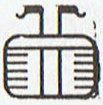|
TRANSLATIONS
The 7th month is Yaxkin and the 14th (twice 7) is Kankin:
It may be coincidence, but probably not. Such details were important in a picture-oriented society - details are important. With yax in Yaxkin presumably meaning 'quick greenery from the sun' (or something similar) kan in Kankin could be its opposite, 'slow - or even dead - branches to the fire'. To my mind comes 'The Snag':
If so, then we should be close to the time when a new fire must be alighted. "Six glyphs at least are clearly pictographic in base: Pop, mat; Sotz, bat; Xul, ?; Kankin, skeleton ribs; Moan, falcon; Kayab, turtle." (Gates) It can be debated whether these identifications are true (e.g. Moan as falcon, more probable a kind of owl I have concluded), but they are worthy to note anyhow. 'Skeleton ribs' are not far from the dry branches in a snag. Skeleton ribs should make us associate to kavakava ribs: ... When Tu'u ko ihu went down to the House of Cockroaches the people were taking the stones from the earth-oven and were throwing out the ends of burning wood. This wood was toromiro. Tu'u ko ihu took two flaming pieces of wood and carried them into that house, into Hare koka. He sat there, and with his sharp pieces of obsidian he carved them into moai kavakava ... Number 320 among the glyph types of Gates means 'firewood': "On purely association grounds this glyph
develops the clear meaning of wood or firewood, as reference to the pictures in the above references will show. I just have to protest. There is no chance glyph 320 can mean wood in general: '... In order to light the fire, dead wood has to be collected, so a positive virtue has to be attributed to it, although it represents absence of life. In this sense, to cook is to 'hear the call of rotten wood'. But the matter is more complicated than that: civilized existence requires not only fire but also cultivated plants that can be cooked on the fire. Now the natives of central Brazil practice the 'slash and burn' technique of clearing the ground. When they cannot fell the forest trees with their stone axes, they have recourse to fire, which they keep burning for several days at the base of the trunks until the living wood is slowly burned away and yields to their primitive tools. This preculinary 'cooking' of the living tree poses a logical and philosophical problem, as is shown by the permanent taboo agains felling 'living' trees for firewood. In the beginning, so the Mundurucu tell us, there was no wood that could be used for fires, neither dry wood nor rotten wood: there was only living wood ... ... only dead wood was legitimate fuel. To violate this regulation was tantamount to an act of cannibalism against the vegetable kingdom ...' In Dr. tz. 50.b a woman bears the sign, with flames, on her back;
above is the glyph 320.1
We have just seen its association with the fire-drill, and the fire-kindling flint. In Dr. page 58 (no picture) the text includes this same flint-form, and also the Xul or torch-bearing animal we have noted in connection with the cauac thunderbolt." In Kankin the sun eye at center bottom identifies the 'dead old tree' as the sun 'tree':
I will now use what can be called 'polar logic' to identify the Kankin glyph as 'skeleton ribs'. We have not yet discussed 13 Mac:
The visual impact says vertical 'ribs' in Mac contra horizontal 'ribs' in Kankin. Then we can compare with glyph type 340 (according to Gates):
Although with a questions mark (Gates is as usual very cautious) 340 probably means 'flesh': "... the above collocations suggest that 340 may mean 'meat, flesh'. The two kinds of food, meat and bread in general, are sharply distinguished throughout Indian usage and language ..." First the red meat will go away, later the bones will be buried. |



















